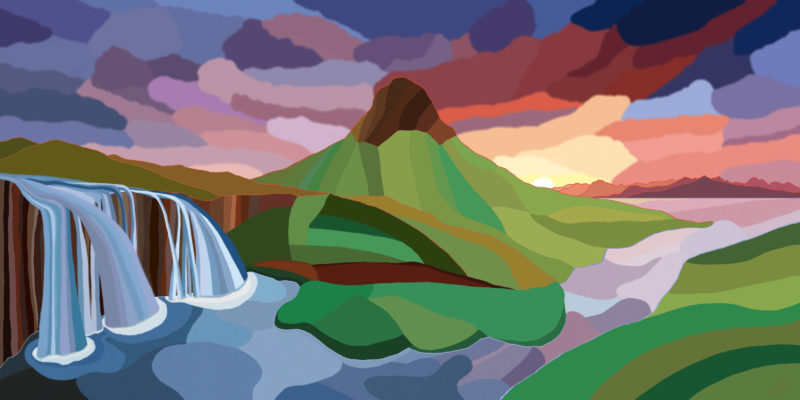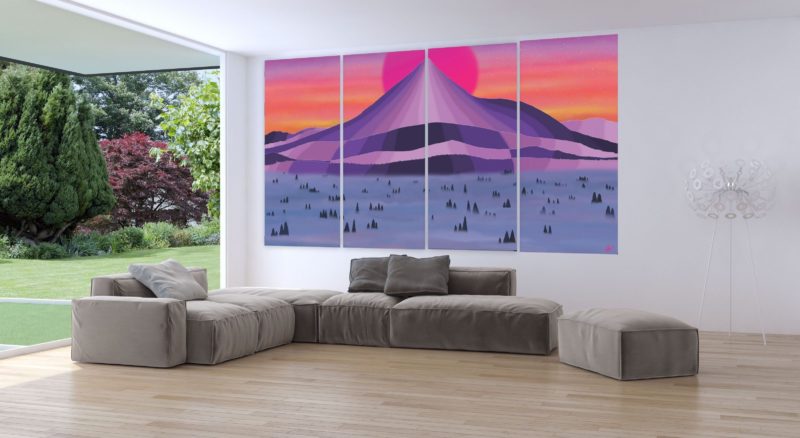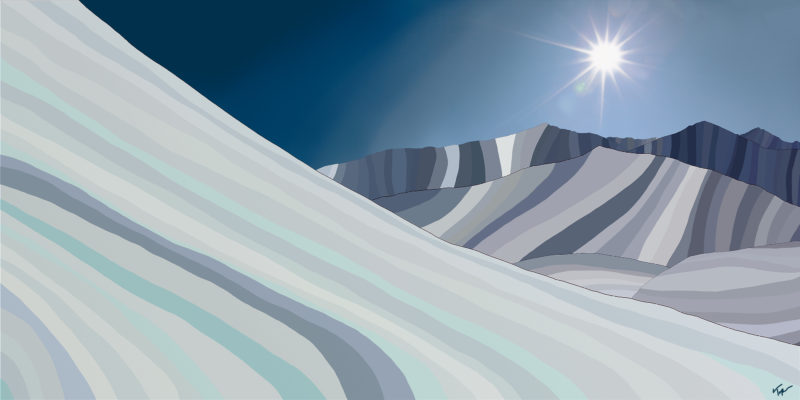The art of Topher Straus is inspired by the grandeur of the US national parks. His digital paintings on aluminum have been gaining admirers all over the country and overseas. We spoke with Topher Straus about his signature technique, philanthropy work, and the importance of quality art shipping.
Artist Talk: Topher Straus on the Sublime Beauty of National Parks
Please tell us about your technique for digital renderings of national parks. How did you come up with it?
Topher Straus: My paintings are based on photographs and my personal experiences. I sit down in front of my computer, think about what I want to do, and start experimenting with collage and color palette. I work with a variety of computer programs, including Adobe Photoshop. I use a stylus and touchpad, but I don't necessarily paint over the photo. Rather, I interpret it by adding brush strokes with my digital brush.
My paintings are large-format, 45 by 90 inches, so when working on my computer, to get a better understanding of the dimensions, I put on a virtual reality headset and immerse myself in the nature I'm painting. It's important for me to feel the rhythm of nature and see how all these subtle colors dance together. I repeat this process several times before the painting is finished.
When the digital image is ready, I first print it on transfer paper covered with oil and minerals. Then I place the paper on recycled aluminum and sublimate it. The heat and pressure cause a molecular reaction so that the ink permanently dissolves into the metal. Then I coat it with glossy resin, which gives the painting a partial mirror finish. When you look at it, you feel like you're part of nature. That's what all my work is about – giving the viewer the opportunity to feel the magnificence of nature and be part of it.

In what way has your background influenced your art?
I only started making art about four years ago. Before that, I kept my art hidden for about thirty years. No more than a dozen people saw my work. It wasn't until I went through a divorce that I realized who I was and who I wanted to be for my son. Before becoming a full-time artist, I worked as a video game maker and filmmaker. I directed several documentaries and international commercials. I've also been an actor in more than fifty commercials. I think my work in front of and behind the camera has given me an understanding of visual arts, camera work, and human perception that I now use in my art. It's funny how everything starts to make sense when you look back at your life.
What motivated you to start painting national parks?
A collector from Boston, Massachusetts, approached me and asked me to paint Zion National Park in Utah, but I didn't want to do that. I didn't think landscapes were for me. But he kept insisting until I finally agreed. I thought, "Okay, I need to start saying yes more often than no." Sometime later, I had a solo show that coincided with the closing of the national parks in the United States because of Covid, which got me noticed. People responded to my work, subject matter, and color palette. That led me to continue my parks series. So far, I have made more than sixty paintings of national parks. I'm halfway through this series, which is constantly evolving.

The colors in your paintings look somewhat exaggerated. Is that your way of emphasizing the natural color palette?
There's a lot in nature that we don't notice, like different shades, their combinations, and the way they interact. I like to expand and exaggerate that to a certain extent to draw the viewer's attention to it. By creating solid lines instead of details, I can represent them better. It's a different interpretation, but it's actually very factual. When you start to perceive nature on the micro level, you see a lot of amazing details that you didn't even know of.
What does your little son think of your art? Does he like it?
Although he's only twelve, Oliver Viking is a huge part of my process and the general manager of Straus Fine Art. He even interviews people. His desk is right next to mine in my studio. I try to include him as much as possible because the life I'm leading now is so extraordinary and rare. I want to share it with him.

You are also actively involved in philanthropy. What kind of projects and organizations do you support?
Giving back to my community and environment is an important part of my work. In the four years since I became an artist, I've raised over $100,000 through auctions. In the last month alone, I've raised $12,000 for four different organizations, including the Boulder Museum of Contemporary Art, a food assistance program, and a mental health foundation. I support several nonprofits: BGoldn, Denver Center for the Performing Arts, The Adoption Exchange, Jamie Beck Foundation, Wings of Hope, and others. I've also been a long-standing advocate for conservation. For example, I recently donated the proceeds from my wine bottled by Sauvage Spectrum to the environmentalist nonprofit Conservation Colorado.
What do you look for when choosing an art shipper for your works?
Art shipping is essential to my business. The works must be impeccable when my clients open them upon delivery. So attention to detail and the way the packages are shipped are extremely important. The turnaround time matters a lot as well. I don't want my clients to wait too long, whether they're in the United States or overseas. After all, It's all part of the experience they have with my work.
Photo courtesy of Topher Straus